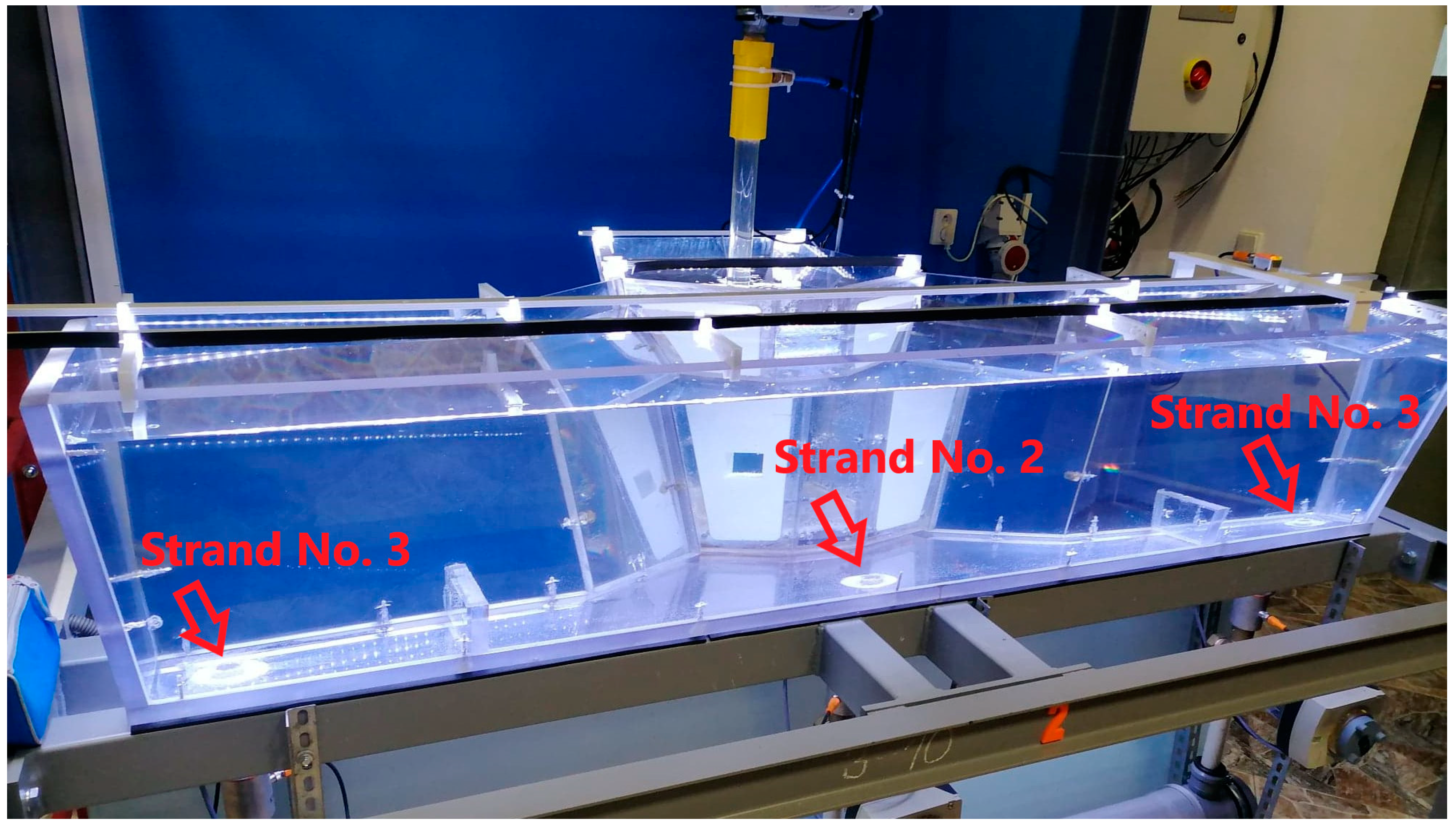Influence of Casting on Two Strands in Three-Strand Tundish on Length of Transient Areas †
1. Introduction
2. Subject of Research and Research Methodology
3. Preliminary Results and Discussion
Author Contributions
Funding
Institutional Review Board Statement
Informed Consent Statement
Data Availability Statement
Conflicts of Interest
References
- Bul’ko, B.; Molnár, M.; Demeter, P.; Baricová, D.; Pribulová, A.; Futáš, P. Study of the Influence of intermix conditions on steel cleanliness. Metals 2018, 8, 852. [Google Scholar] [CrossRef]
- Bul’ko, B.; Demeter, P. Laboratory of Simulation of Flow Processes; Technical University of Košice, Institute of Metallurgy, Department of Metallurgy and Foundry: Košice, Slovakia, 2017; Available online: https://ohaz.umet.fmmr.tuke.sk/lspp/index_en.html (accessed on 8 May 2023).
- Fogaraš, L.; Šmigura, P.; Buľko, B.; Demeter, P.; Hubatka, S.; Demeter, J.; Šmigura, P. Investigation of optimal transient conditions in t-shape tundish during steel intermixing. In Proceedings of the 30th International Conference on Metallurgy and Materials, Brno, Czech Republic, 17–19 May 2023. [Google Scholar]
- Warzecha, P.; Hutny, A.M.; Warzecha, M.; Merder, T. Hydrodinamic conditions of flow in the tundish depending on selected technological parameters for different steel group. Arch. Metall. Mater. 2019, 64, 65–70. [Google Scholar] [CrossRef]
- Warzecha, P.; Hutny, A.M.; Warzecha, M.; Merder, T. Optimization of steel flow in the tundish by modifying its working area. Arch. Metall. Mater. 2016, 61, 2071–2078. [Google Scholar] [CrossRef]

Disclaimer/Publisher’s Note: The statements, opinions and data contained in all publications are solely those of the individual author(s) and contributor(s) and not of MDPI and/or the editor(s). MDPI and/or the editor(s) disclaim responsibility for any injury to people or property resulting from any ideas, methods, instructions or products referred to in the content. |
© 2024 by the authors. Licensee MDPI, Basel, Switzerland. This article is an open access article distributed under the terms and conditions of the Creative Commons Attribution (CC BY) license (https://creativecommons.org/licenses/by/4.0/).
Share and Cite
Šmigura, P.; Buľko, B.; Demeter, P.; Dubec, D.; Demeter, J.; Fogaraš, L.; Hubatka, S. Influence of Casting on Two Strands in Three-Strand Tundish on Length of Transient Areas. Proceedings 2024, 108, 16. https://doi.org/10.3390/proceedings2024108016
Šmigura P, Buľko B, Demeter P, Dubec D, Demeter J, Fogaraš L, Hubatka S. Influence of Casting on Two Strands in Three-Strand Tundish on Length of Transient Areas. Proceedings. 2024; 108(1):16. https://doi.org/10.3390/proceedings2024108016
Chicago/Turabian StyleŠmigura, Peter, Branislav Buľko, Peter Demeter, Dominik Dubec, Jaroslav Demeter, Lukáš Fogaraš, and Slavomír Hubatka. 2024. "Influence of Casting on Two Strands in Three-Strand Tundish on Length of Transient Areas" Proceedings 108, no. 1: 16. https://doi.org/10.3390/proceedings2024108016
APA StyleŠmigura, P., Buľko, B., Demeter, P., Dubec, D., Demeter, J., Fogaraš, L., & Hubatka, S. (2024). Influence of Casting on Two Strands in Three-Strand Tundish on Length of Transient Areas. Proceedings, 108(1), 16. https://doi.org/10.3390/proceedings2024108016







